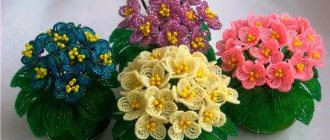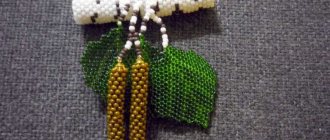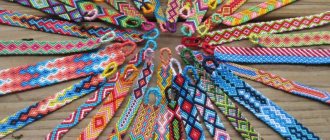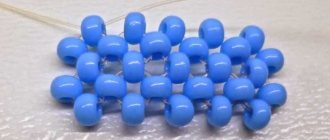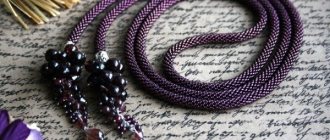The value of manual labor
Many people like to receive handmade items as gifts. They are very individual. After all, a master puts his soul into his work. Color, appearance, size are selected according to the preferences of the future owner.
The keychain itself is a fairly universal gift. This accessory can be given to any person, regardless of gender, age, occupation and hobbies. It can become a harmless decoration, or it can also be a very practical thing.
Keyrings can be either flat or three-dimensional shapes. For example, you can weave a beaded keychain for a man with the logo of his car brand or the logo of his favorite football team, in the shape of a ball (soccer, volleyball, basketball).
For a glamorous girl, a keychain in the shape of scarlet lips or a shoe with thin heels is suitable. Kids will be happy with keychains in the shape of fruits (or their slices) and cute little animals. Diversity is limited only by the imagination of the master.
In 2022, a very relevant gift is a beaded mouse keychain.
weaving and master classes for beginners
Keychains are always popular with people and everyone has at least one item that has them on them. But every day their prices are rising quite well, so you should learn how to make them yourself. In this article you will see simple beaded keychain patterns for beginners.
Weaving keychains from beads with your own hands is not so difficult, because they are small in size and do not require additional time or effort. Sometimes you come across products in which you can see jewelry work and a good hand of the craftsman, but there is nothing particularly complicated there, you just need to devote a little more time to it than usual.
Ladybug
Weaving materials:
- Beads of red and black colors;
- Special carbine;
- Wire.
Let's start work.
The basic scheme that can be used is:
And the description is given below:
- We weave in parallel weaving in rows. The top front will be more red, and the bottom back will be completely black.
- First row: five red; five black.
- Second row: pair of red, black, pair of red; five black.
- Third row: three red, black, three red; seven black.
- Fourth row: red, black, four red, black, six red; nine black.
- Fifth row: six red, black, three red, black, a pair of red; nine black.
- Sixth row: three red, black, red, black, five red; nine black.
- Seventh row: five red, black, five red; eight black.
- Eighth row: red, black, two red, black, two red, black, red; seven black.
- Ninth row: six red.
- Next, we make one strip of five black beads, forming antennae, attach a carabiner and secure the wire.
A beautiful keychain and talisman for good luck is ready:
Cube
An extraordinary solution to decorate something. Below is a master class on this type of weaving.
Weaving materials:
- Purple beads;
- Medium size bead;
- Wire;
- Clasp and ring for keychain.
Let's start work.
You can make a dice, as in the diagram:
Or you can ignore the highlighted circles and make a regular one-color cube:
- We make six flat squares from small beads, ten rows of ten beads each.
- Then we connect five pieces together with wire, put a bead inside and attach the last side.
- Next, attach the ring for the keychain and the product is ready!
Here are such simple and quick instructions for a light keychain. The ball inside must be smaller in size than the free space in order to hit the walls and make sounds. You can give this fun cube to a friend and the gift will remind you of the wonderful moments spent together.
Heart
Weaving materials:
- Pink or red beads;
- Braiding line;
- Keychain clasp.
We start working with straight weaving according to the pattern:
We make two such parts, and then sew them together using fishing line or regular thread. We attach a ready-made clasp for a keychain or a self-made one, as in the photo below.
This heart will look beautiful with a phone or keys in a woman’s hand.
Video selection
Videos showing other products can be viewed below:
https://youtube.com/watch?v=bSC3WrKEDPQ
https://youtube.com/watch?v=VVXq0Jx1Fvg
How to make a keychain from beads
Before starting work, you need to choose a bead weaving pattern for the future keychain, as well as stock up on the necessary tools and materials.
There are a huge variety of patterns for creating keychains from beads on the Internet, both free and paid, for every taste. For starters, color photos of diagrams with step-by-step drawings and descriptions are suitable.
You will need to purchase the following materials: beads, beads of different sizes, monofilament, thin wire. You also need the following tools: a thin bead needle, scissors, pliers, a ruler, a sheet of velvet paper so that it is convenient to work with beads and it does not slip.
Note!
- Beaded trees: beautiful and unusual DIY beadwork. Detailed diagram of tree weaving + photo examples of finished work
- Beadwork for beginners - step-by-step instructions for weaving with beads with your own hands. Tips for beginners + photo reviews
Crafts from beads - TOP-160 original ideas for creating crafts with your own hands. Bead weaving patterns for beginners with photo reviews
Solid cube
A master class on making a keychain from three-dimensional cube beads for a beginning needlewoman lasts on average 3 hours.
It is recommended to start working with beads in one color.
The basis is mosaic weaving.
- Weave 6 squares, which are then sewn together to form a three-dimensional cube figure.
- There are 12 beads on the fishing line. This is the width of the square. The height is gained from 10 rows. The size of the figure will be 2x2 cm. There should be 6 pieces.
- Five squares are sewn together. After this, the cube is filled with foam rubber to maintain its shape. The sixth square is sewn on.
- A chain with a ring is sewn to the finished keychain.
Tips for Beginners
How can you not discourage yourself from bead weaving the first time and end up disappointed?
- It is worth choosing beads and beads of good quality. They must be even and of the same caliber.
- a beading needle with the thinnest eye will do.
- The workplace should be well lit - you should protect your eyesight.
- For the first product, it is better to choose a simple pattern and practice weaving simple flat keychains.
- It makes sense to put next to you a photo of a beaded keychain that is currently in work. This will inspire and help psychologically.
Geometric figures
To weave a cube of beads, you first need to weave a rectangular fabric using monastery weaving or, in other words, a cross. Take a thin wire to work with to shape your product.
Weave a cube from a square rope, but use more even and high-quality beads for it. At the end of the work, add beads of the same or contrasting color to align the walls.
You can place a bead inside such a cube without finishing the product beforehand and of such a size that it does not fall out.
Beaded balls are also made in several ways. The first is braiding a wooden bead using the mosaic method, which involves the use of more expensive beads.
Products using not only beads, but also other beads, larger sizes or bicones, turn out beautifully. These keychains will look quite glamorous. The balls are woven in a circle using the monastery cross method. Add tassels on chains.
Related article: How to crochet a cosmetic bag
To create beaded keychains, it is better to use good Japanese beads. The product will look smooth and will only please the eye, even though the beads are expensive, but a large amount will not be required for the product. Quality work done can be given as a gift.
Flat keychain mandarin slice
The following is a step-by-step instruction on how to make a keychain from beads.
You will need beads of three colors: white, orange and dark orange. It is better to give preference to first-class Czech beads - they have a good price-quality ratio. You also need to prepare monofilament, a beading needle, scissors and a cotton pad.
For the first row, put 6 white beads on a thread and close them in a circle, threading the thread through the first bead.
For the second row, string orange beads one at a time and thread them through the white beads of the first row.
Third row - white beads are woven one at a time between the orange ones.
Note!
Butterfly from beads: TOP-100 photos with simple patterns for weaving a butterfly with your own hands. Unusual bead ideas + step-by-step master class
Beaded birch: beautiful and original DIY products. Detailed technology of weaving with beads at home + photos of finished works
Weaving with beads - instructions for making it yourself. Clear weaving patterns and technology reviews + photos of finished work
Fourth row - 2 orange beads are woven between the white beads of the third row.
Fifth row - the white beads should match the white ones between the two orange ones in the previous row.
In the same way, you need to make several more rows (the number of rows will depend on the desired size of the slice). Next is one white row without increments and two more rows of dark orange beads also without increments.
Next, a slice is formed by folding the circle in half, and a cotton pad, also folded in half, is sewn inside. If the size of the slice is larger than a cotton pad, then the slice is simply filled with cotton wool or toy filler.
And if it’s smaller, then the disk can simply be cut to the size of the slice. The piece is sewn up with a brick stitch. And then the mount for the key rings is sewn on. This could be, for example, a chain with a ring.
Note!
- Beaded bracelets: TOP-120 photos with simple weaving patterns for beginners. Ideas for ready-made beaded jewelry + step-by-step master class
- How to embroider with beads: TOP-200 photos with simple patterns for beginners. Bead embroidery technologies + step-by-step master classes
What you will need
Prepare beads of different colors and shapes to make the craft as original as possible. Japanese and Czech beads are valued for their quality. Additional materials and tools used include threads, monofilaments (as thick as regular sewing thread, but much stronger), thin brass or copper wire or fishing line, elastic, filler (cotton pads, cellophane, padding polyester), thin bead needle, scissors, tweezers, ruler, small pliers. You will also need various accessories: carabiners, rings, chains, buttons, fasteners, ribbons, laces for hanging, tassels.
Bead weaving methods
There are several ways to weave with beads.
Brick weaving in finished works looks like brickwork. The beads in the rows are arranged horizontally and each row is shifted relative to the previous one by half a bead. Both flat and three-dimensional products are made using this method. The fabric turns out to be quite dense, the beads are closely spaced and there are no gaps between them.
Mosaic weaving in finished products looks very similar to brick weaving, but the only difference is that the beads are rotated 90 degrees. However, the weaving technique itself is very different: the beads are arranged upright and each of them lies in a checkerboard pattern relative to the previous row.
The product also comes out very dense. The work uses monofilament. This technique has options - weaving in a circle or cylindrical weaving.
Hand weaving (square stitch, tapestry weaving) when finished looks like a fabric made on a bead weaving machine. The difference between this method is the position of the beads strictly above each other. Each next row in the position of the beads corresponds to the previous one. The canvas is also thick. Monofilament or fishing line is used for work. This method is used to create both flat and volumetric products.
Monastic weaving is also called cross weaving. The main component of this method is a cross with four beads. The product is made up of many crosses. At first glance, the technique seems complicated, but in reality everything is quite simple. This method is used for flat and three-dimensional products. The work uses mainly monofilament. In rare cases, wire.
Volumetric parallel weaving. With this method, the beads are not in the same plane, but above each other. The work uses wire, less often fishing line. This technique is the most common for creating three-dimensional beaded items, such as animals.
For beginners, the easiest way to weave is flat parallel weaving. The work is carried out on wire. The finished products look like they consist of parallel rows, and any row includes beads placed in a row.
As mentioned above, there are a lot of patterns for weaving with beads on the Internet. You can also use cross stitch patterns to work with hand weaving techniques. With this method, the beads are placed strictly on top of each other, just like in cross stitch embroidery.
Weaving options
You can create flat or three-dimensional products from beads. Each model uses its own scheme and technique.
Flat figures
To create flat, elastic and beautiful models using the “brick stitch” method, very smooth, calibrated beads are used, which are not cheap. In this method, the beads are tightly adjacent to each other like brickwork. Name keychains, car badges and many other products are woven using this method.
Volumetric figures
Three-dimensional models are obtained using the mosaic or parallel weaving method, in which the beads are stacked vertically. Wire is used as a frame for such products.
You can weave beads in other ways. For example, there is hand weaving, cross weaving or monastery weaving. Some techniques will require a special miniature machine, which you can easily make with your own hands from an empty box.
Volumetric keychain
A short instruction on how to make a volumetric keychain from beads:
- You will need a step-by-step photo diagram of the desired product. According to the text description, it is very difficult for a beginner to make a three-dimensional keychain. So the first step is to find a suitable scheme on the Internet.
- You need to prepare the necessary materials: beads, wire, beads... All this can be bought at a handicraft store.
- It’s better to put a photo of the finished product in front of your eyes, which is to be worked on. This will be inspiring and it will be easier to understand the photo diagram.
Snowflakes
What would New Year be without snow? Don't forget about snowflakes, because they are almost the most important attribute of the New Year. They fascinate with their beauty and give an incredibly fabulous atmosphere. Weaving them from beads will not be difficult - stick to the photo diagram and you will definitely succeed!
I recommend watching this video!
Snowflake From Beads! We are preparing for the new year!
Volume keychain cube
Even a novice craftswoman can weave the finished product from this master class in 3 hours. For the first time, it is better to weave a single-color cube - it will be easier.
Required:
- beads (preferably Czech first grade with even beads)
- monofilament
- beading needle
- cotton wool or foam rubber
- chain with a ring for attaching a keychain
- good mood and patience
Step-by-step weaving instructions
The work uses the mosaic weaving method. You need to weave 6 identical squares.
The width of the square will be 12 beads, and the height needs to be woven 10 rows. You will get a square measuring 2 by 2 cm.
Next, 5 squares are carefully sewn together to create a cube with one wall missing.
It is necessary to fill the cube with cotton wool or foam rubber and carefully sew on the 6th wall.
All that remains is to attach the keychain chain to the finished cube. Voila! The keychain is ready!
Subtleties of manufacturing
The volumetric weaving technique is based on alternating tiers. In this case, the ends of the wire are passed sequentially through the beads. The easiest way to understand this is with an example:
The red arrow shows the stringing of new beads, which is described below in paragraph 4. And the blue arrow shows a piece of wire entering from the opposite end and securing the beads as a tier.
The upper tier is attached to the left piece, the lower tier to the right, then these pieces are pulled out through each other’s beads.
To cut the wire, wire cutters or metal scissors are recommended. The remaining piece should be carefully hidden in 1-2 beads, and before that carefully twisted.
Bead weaving with children
It is very useful to get kids interested in bead weaving. Working with beads develops fine motor skills, teaches concentration and perseverance. And it’s just interesting and fun to weave a beautiful keychain together. It’s better to start with simple and understandable diagrams. Children will be interested in figuring them out for themselves.
But we must be ready to help them so that they do not lose interest at the first difficulties. Weaving a keychain from beads with your own hands as a gift for a friend is exciting!
Tools and materials Time: 2 hours • Difficulty: 2/10
- needle with thread;
- wooden egg;
- beads of three colors - light green, dark green and red;
- weaving pattern (shown below).
A blank like the one in this article can be an excellent start to a future egg, but for now we’ll make a keychain out of it and learn how to weave.
From the edges of the workpiece, you can continue to weave, and then embroider the product to your liking and using all your imagination. This is how, in a simple and easy way, you can make excellent souvenirs, keychains and pendants, which will then delight all the happy owners.
Step 1: braid the workpiece with mesh
We take our testicle and braid it with beads of the same color according to the description. First, the belt is woven with a three-by-three bead mesh, and the top of the head is woven using a mosaic technique in a circular pattern. This is what will allow you to combine beads of different sizes and shapes. You will learn how to make a keychain from beads thanks to our accessible master class with a detailed description and photo lesson.
Scheme of weaving a keychain from beads
Click to enlarge
We weave the belt until it fits our workpiece quite tightly. Then we sew the 1st and last row. We pass the thread through the beads of the last diamond, thereby securing it and tying it with a double knot. We hide the unnecessary end in the weaving itself. Let's try our belt on the blank. Ideally, it fits very tightly, and the thread between the beads is not visible.
Click to enlarge
Now we begin to weave the crowns in a circular pattern. We thread the thread into the outer bead. If there is too much space between the outer beads, then weave the belt in a circle, collecting 3 beads each. By gradually and evenly decreasing we will weave the crowns. We decrease it if there is not enough space between two adjacent beads for a bead in a new row.
Step 2: decorate with embroidery
We can now embroider our finished egg from one type of bead using a variety of techniques and methods. Here we also used horizontal beadwork of a larger size, which will give the image of a berry.
As soon as the egg is ready, we decorate it with embroidery of a different color. To begin with, let's collect 16 beads, and counting 8 from the end, thread them through the eighth needle. Now we weave 3 beads, and thread them through every fourth. When we returned to 1 bead of the set, we begin a new row. Let's collect 5 beads, and then 3 beads, threading each time through the middle one.
Step 3: weaving leaves
Among other things, you can decorate a keychain made of beads with your own hands and decorate it with any elements of the patch. In this case, the leaves that you see in the diagram were used:
In order for our testicle to become a beaded keychain or a pendant, we sew a ring and a lock to it for attaching the keychain. Or you can make the berry more stable by sewing beads in a circular pattern. So our Easter egg is ready, it’s a keychain, it’s a pendant! Great start and experience for a beginner!
We are sure that your skills will only grow and you will definitely find other beautiful products useful in bead embroidery with your own hands.
Christina All posts by the author (1123)
Source: https://pleteniebiserom.ru/2011/07/brelok-iz-bisera/
Useful tips
If you run out of wire when working with the parallel or volumetric weaving method, it is easy to extend it. Another piece of wire is taken and passed through the previous woven row. After this, the ends of the broken wire need to be twisted with the frame of the product. Now you can continue weaving on a new piece of wire.
This method is also suitable for working with fishing line. If the entire product requires a fairly long fishing line, then it is better from the very beginning to take a piece that will not get tangled and will be convenient to work with. Then the line can be lengthened in the manner described above.
If you need to create a product larger than it is described in the master class (diagram), then you will want to increase the number of beads in each row. However, this is wrong, because at the same time an increase in the number of rows is required. This is not always within the power of a novice craftswoman. You can simply use larger beads.
Regular sewing needles are not suitable for weaving with beads - even the thinnest sewing needles have an eye that is too thick and the beads will not pass through it. Therefore, it is worth taking bead needles, and the larger the needle number, the thinner it is.
You don't need a needle to weave with wire. But when weaving on a fishing line, you need to look at the situation whether a needle is needed or not. Often it’s easier and faster with a needle. We need to try options.
Brick beading technique for beginners
Products made from beads look very original and beautiful. Professional craftswomen know different methods of beading:
- brick
- mosaic
- French
- parallel
- monastic
- openwork
All crafts woven using these methods are inimitable and unique. The brick technique of weaving with beads has proven itself well.
Thanks to her, extraordinary decorative elements, flowers, keychains, jewelry and accessories are created. This technique can create even the most complex shapes.
Completed crafts are distinguished by neatness, even rows, density and integrity. In this article I will tell you how to weave a panda using the brick technique.
Before starting knitting, experienced needlewomen recommend that novice craftswomen pay attention when choosing beads. In order for the product to be smooth, beautiful, and without flaws, each bead must be the same size.
Working material
In the process of work we will need the following material:
- beads in white, black, gray (12), light green (2) and pink (6) shades;
- ring for keychain;
- needle;
- black thread;
- scissors.
Having prepared all the necessary material, you can begin the exciting creative process.
Brick weaving master class
I bring to your attention a detailed master class on panda brick weaving.
Panda diagram
First we study the weaving pattern. We will start weaving from the head. The column on the right shows the required number of beads in each row. On the left are the rows.
Beginning of work
We will skip the first row for now and start weaving from the second row, and then we will come back and finish the two beads of the first row.
We take a needle and thread and string a black bead, lowering it almost to the end.
Next, from the tip side, we pass the needle through the bead and tighten the thread.
We collect the next black bead. We pass the needle through the first element from the side opposite the working thread and tighten it.
Next, insert the needle into the second bead.
We collect one white piece of glass and insert the needle into the hole opposite the thread exit and tighten.
- Now we insert the needle into the white bead, as in the bottom photo.
- We put on another bead and insert a needle into the hole of the previous element.
We pass the needle through the last bead, pointing upward. Don't forget to tighten the thread.
- We take another bead and do the same steps as before.
- We continue to knit according to the pattern using the same technique.
- The first row is ready!
Head braiding
Next we will weave the third row. Having reached half, we will go up and weave the initial row, go down and continue what we started.
- We collect black glass and insert a needle into the thread between the beads.
- Now insert the needle from above and tighten the thread.
Take another bead and thread the needle through the same loop as before. We do this to create brickwork.
- We insert the needle into the hole from above and tighten the fiber.
- We take a white bead, hook it to the underlying thread, and pull it up.
- We insert the needle from top to bottom.
- Using the same principle, we weave two more beads.
- We pass the needle through the bead and weave two beads of the first row.
Thus, we knitted the first row. This is the top of the panda, where there will be a loop for attaching the keychain ring. So that we don’t have to come back, we’ll make the loop right away. We string ten black pieces of glass and lower them to a white bead.
- We pass the needle into the previous bead and tighten the thread.
- To be safe, we draw a circle with thread again.
- Then we pull the thread in the unfinished third row and continue to work.
- Following the schematic image, we weave further.
- Using the same method as before, we weave three white and two black beads.
- Subsequent rows are narrowed, so we will weave, grabbing one thread at a time between the beads.
- When the row begins to expand, we will need to thread it twice into one loop from the two extreme sides.
In this spirit, we continue to engage in an interesting type of creativity, strictly following the provided scheme. So we got the first element - the panda's head. It turns out very beautifully.
Bead selection
As mentioned earlier, for weaving keychains it is better to choose first-grade Czech beads. It has a good price-quality ratio and fairly even beads of the same size.
There are also Japanese beads. Its quality is higher than that of the Czech one and, accordingly, the products may turn out more equal. However, the price of Japanese beads is higher.
Chinese beads are the cheapest, but they are not suitable for weaving keychains, since their beads are very uneven and require serious calibration before work. And here each craftswoman chooses beads according to her wallet.




